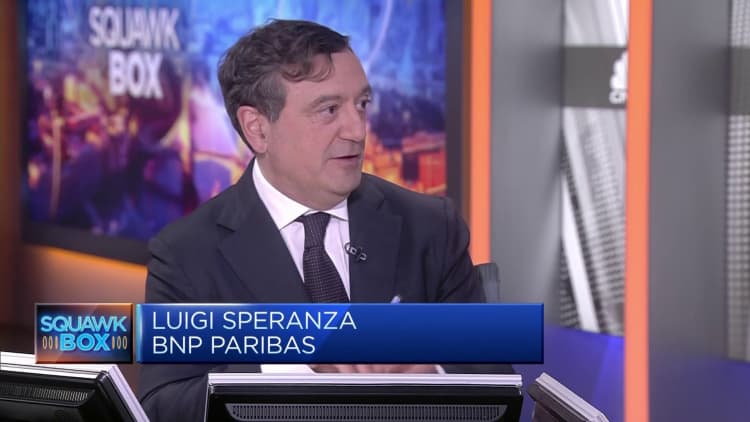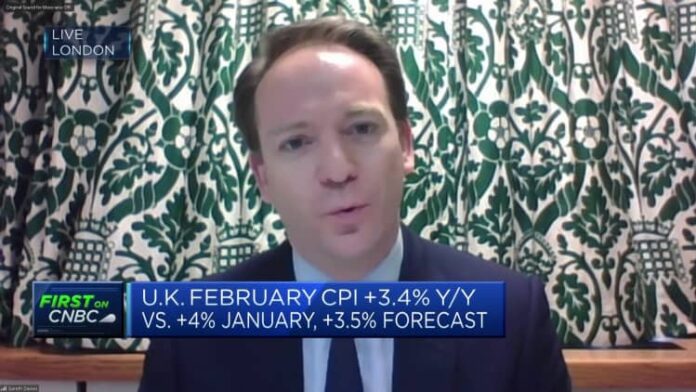The Bank of England in the City of London after figures showed the UK economy slipped into recession at the end of 2023.
Yui Mok | Pa Pictures | Getty Images
LONDON – The Bank of England is widely expected to leave interest rates unchanged at 5.25% on Thursday, but economists are divided over when the first cut will come.
Data on Wednesday showed headline inflation fell more than expected to an annual 3.4% in February, hitting its lowest level since September 2021. The central bank expects the consumer price index to return to its 2% target in the second quarter as the household energy price cap is cut again in April.
The larger-than-expected decline in both headline and core numbers was welcome news for policymakers ahead of this week's interest rate decision, although the Monetary Policy Committee has so far been reluctant to provide clear guidance on the timing of its first cut.
The UK economy fell into a technical recession in the final quarter of 2023 and stagnated for two years following a huge shock to gas supplies following Russia's invasion of Ukraine. Kallum Pickering, senior economist at Berenberg, said the bank would likely hope to ease its policy soon to support a burgeoning economic recovery.
Pickering suggested that given Wednesday's inflation data, the MPC could “concur with current market expectations for a first rate cut in June”, which it could then consolidate in its updated economic forecasts in May.
“Further moderate easing at the March meeting would be in line with the trend in recent meetings, with policymakers gradually shedding their hawkish stance and instead turning to the question of when to cut rates,” he added.
At the February meeting, two of the nine MPC policymakers still voted to increase the key rate by another 25 basis points to 5.5%, while another voted to cut it by 25 basis points. Pickering suggested that both hawks could choose to hold rates this week or that another member could favor a cut, noting that “the early moves of dissenters often signal impending turning points” in the bank's rate cycles have.
Berenberg expects headline annual inflation to fall to 2% in the spring and remain near that level for the rest of the year. It expects the bank to make five 25 basis point cuts to bring the key rate to 4% by the end of the year, before further 50 basis point cuts to 3.5% in early 2025. This would still mean that interest rates would exceed inflation for at least the next two years.
“The risks to our call are that there will be fewer cuts in 2025 – particularly as the economic recovery gathers pace and policymakers begin to worry that strong growth will put pressure on wages in already tight labor markets could fuel,” Pickering added.
On the right path, but not “home and dry”
A key focus of the MPC was the tight labor market in the UK, which it feared could entrench inflation risks in the economy.
January data released last week showed a weaker picture across all labor market metrics: wage growth slowed, unemployment rose and job vacancies fell for the 20th straight month.
Victoria Clarke, chief UK economist at Santander CIB, said that after last week's weaker jobs data, Wednesday's inflation data was a further indication that embedded risks had eased and that inflation was on track for a sustained return to target.
“Nevertheless, services inflation has largely followed the BoE forecast since February and remains elevated. Therefore, we do not expect the BoE to conclude that it is “home and dry”, especially with April being a critical point for inflation in the UK “Nationwide living wage rise of almost 10% and many Companies have already announced their living wage increases and implemented some,” Clarke said via email.

“The BoE needs data on how far this impacts wage setting and concrete information on how much goes into price setting in the following months.”
Santander believes the bank may conclude it has enough data to cut interest rates in June, but Clarke argued a rate cut in August would be “more cautious” given the “monthly jitters” in jobs figures.
That assessment was echoed by Moody's Analytics on Wednesday, with senior economist David Muir also pointing out that the MPC will need further evidence to be satisfied that inflationary pressures have been contained.
“In particular, service sector inflation and wage growth must continue to moderate. We assume that this necessary easing will take place in the first half of the year, so that a rate cut can be announced in August. However, there is currently high uncertainty surrounding the timing and extent of rate cuts this year,” Muir added.

















